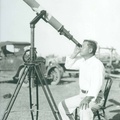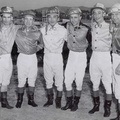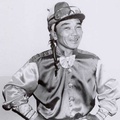My name is Tim Asamen, and, yes, I am a full-fledged Sansei. I say that because my surname is so strange that it can be downright baffling to ethnic Japanese. Whenever I introduce myself to both Japanese nationals and Japanese Americans, it always causes confusion. When I say “Asamen” the usual response is “huh?” It’s even worse when some of my own family members say our name because they don’t pronounce it with a Japanese accent, so it sounds more like “Osmond” without the “d.”
Invariably I’m asked, “Are you sure it’s Japanese?” Then the inevitable, “How is it written in kanji?” I have meishi (name cards) printed in Japanese. I know that Nikkei are supposed to write their Japanese names in katakana but out of necessity I’ve had to have my surname printed in kanji just because of all of the incessant questioning. Then, when Japanese nationals see my name written in kanji as 浅面, they usually gasp, are always overcome by a look of bewilderment, and exclaim, “I’ve never seen such a name!”
My mother, Kiyo, had a very common maiden name—Sakamoto. She told me that when she was growing up she would cringe every time her Hakujin teachers called roll and pronounced her name as kai-yo-ko sack-a-moe-toe. But what about when fellow Nikkei mispronounce your name? One Nisei emcee had to introduce me at a public event in Little Tokyo and when he came to my name printed in the program he got tongue-tied and blurted out, “Tim Asami”! On another occasion, a Nisei pronounced my name as “Asamini.” Note that in both instances, they couldn’t help but add a vowel sound to the end of my surname.
What makes Asamen so unusual is that it ends with an “n,” which is the only solo consonant in the Japanese language. By contrast, I would guesstimate that 99 percent of all Japanese surnames end with a vowel.
My grandparents hailed from Kagoshima Prefecture, my grandfather emigrating around 1903. I visited my grandparents’ hometown in 1999, and upon my return I showed a friend a picture I took of my ancestors’ grave with the inscription 浅面家之墓 (Asamen family grave) carved in the stone. My friend is a native of Yokohama, and by then we had known each other for about ten years. For the first time in all those years she admitted that she didn’t think that Asamen was a real Japanese name until she saw the photo. She confessed that she assumed that my grandfather changed his name when he immigrated to the United States or that immigration officials misspelled his name when he was processed through the port of entry. But that wasn’t the case.
Kagoshima has a preponderance of unique surnames so I’m really not alone. In Kagoshima, hearing an unusual name is a common occurrence; it’s no big deal. In fact, I’ve been to Kagoshima three times and not once did anyone ever question my name! It gave me a real sense of belonging. The reason that there are so many unusual surnames in Kagoshima is the region’s geographic isolation at the southern-most tip of the southernmost island of Kyushu, coupled with the fact that historically there was very little transmigration or intermingling between the inhabitants of Kagoshima and people from other parts of Japan. Those same conditions gave rise to Kagoshima’s distinct dialect, which is notoriously known to be incomprehensible to anyone who is not from there.
I don’t know this for a fact, but I have a theory that Kagoshima has more surnames that end with an “n” than any other region in Japan. Some of them are: Amamen (雨面), Benkan (弁官), Bunden (分田), Chiran (知覧), Chuman (中馬), Chumen (中面), Doumen (堂免), Godaiin (後醍院), Gongenmen (権現免), Gonshuin (権執印), Ijuin (伊集院), Irikiin (入来院), Kedoin (祁答院), Kuden (久田), Kumanden (九万田), Kuniin (救仁院), Makinodan (牧之段), Makinoden (牧野田), Manzen (万膳), Rokutan (六反), Shiokan (塩官), Shuin (執印), Somen (造免), and Suwamen (諏訪免). There is only one surname with a consonant ending that I’ve repeatedly encountered outside of the Kagoshima area and that is Ban (坂). But I’m sure there are others.
Most Japanese names originated from place names. I researched my surname and it is no exception. My ancestors came from a rural village called Kami Ijuin-mura (上伊集院村), which was known as Matsumoto-cho when I last visited, but it has since been merged with Kagoshima City. In feudal times, Kami Ijuin-mura was further divided into smaller administrative units called kado (門). Only villages in Satsuma domain (Kagoshima’s pre-modern name) were composed of kado. Each kado in Kami Ijuin-mura had its own name, and one was named Asamen-kado (浅面門). Thus my surname is a derivative of Asamen-kado. Even by Kagoshima standards, my name is rare. According to prefectural records, in 1994 there were only thirteen households in the whole of Kagoshima Prefecture with the Asamen name. All are either directly or distantly related. So if you ever meet anyone named Asamen, that’s my kin!
In the course of my research, I was astonished to discover—as was my family—that according to the 3-volume Nihon seishi daijiten, the go-to resource for Japanese names, there is an alternative reading for my surname. Evidently, it can also be pronounced as “Asaomote” (アサオモテ ). I can already hear how that would be butchered: ass-how-moat. No thanks!
© 2014 Tim Asamen








